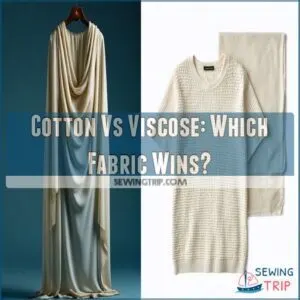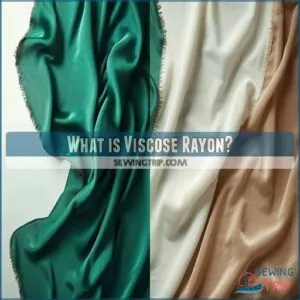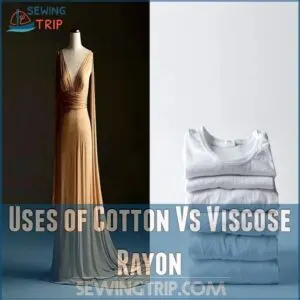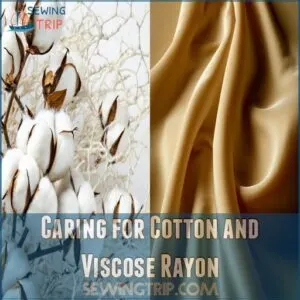This site is supported by our readers. We may earn a commission, at no cost to you, if you purchase through links.

Cotton, nature’s gift from the cotton plant, offers superior breathability and durability that’ll keep you comfortable through countless washes. Cotton wins the absorption game and stands up better to wear and tear.
Viscose, crafted from wood pulp through chemical processing, brings a silky smooth feel and elegant drape to your clothes, though it needs gentler care. Viscose’s lightweight nature makes it perfect for those breezy summer outfits.
Understanding these unique qualities helps you make smarter fabric choices that fit your lifestyle and values.
Table Of Contents
- Key Takeaways
- What is Cotton?
- What is Viscose Rayon?
- How is Cotton Fabric Made?
- How is Viscose Rayon Fabric Made?
- Pros and Cons of Cotton
- Pros and Cons of Viscose Rayon
- Comparing Cotton and Viscose Rayon
- Uses of Cotton Vs Viscose Rayon
- Caring for Cotton and Viscose Rayon
- Frequently Asked Questions (FAQs)
- Conclusion
Key Takeaways
- You’ll find cotton more durable and easier to maintain, with superior breathability and moisture-wicking properties that make it ideal for everyday wear and active lifestyles.
- You can count on viscose for its silky smooth texture and elegant drape, though you’ll need to handle it more carefully as it is prone to shrinking and requires gentle washing.
- You’re better off choosing cotton for hot weather and high-activity situations, as it absorbs moisture better and keeps you cooler than viscose.
- You’ll see viscose absorb dyes more readily and produce more vibrant colors, but you’ll get better long-term sustainability and durability from cotton garments.
What is Cotton?
Imagine this: a fabric so soft and breathable it feels like a gentle whisper against your skin. That’s cotton, one of the world’s oldest and most beloved textiles.
It all begins with the cotton plant, a hardworking marvel of nature. As its fluffy white fibers grow, they’re plucked, spun into yarn, and woven into countless fabric types—like the crisp finish of broadcloth or the airy touch of poplin.
What makes cotton special isn’t just its history but its incredible versatility, with cotton texture varying widely based on type, processing, and weaving, as seen in cotton texture types.
Long-staple varieties such as Egyptian or Pima cotton elevate the cotton feel—they’re smoother, stronger, and even soften over time.
Highly absorbent, breathable, and hypoallergenic, cotton is a dream for anything from crisp shirts to cozy sheets. It’s a timeless choice, trusted for its comfort and durability.
What is Viscose Rayon?
Viscose, also called rayon, is a semi-synthetic fiber made from wood pulp. Its silky feel and elegant drape make it a popular choice for fashion and home textiles. Viscose production involves chemical processes that transform cellulose into a soft, shimmering fabric, often resembling silk. While it feels luxurious, it’s less durable than cotton, requiring careful handling to maintain quality. Viscose fibers are often blended with spandex to create a smooth, supple fabric that molds to the body, as seen in cotton vs viscose difference.
Compared to cotton, viscose has its strengths and limitations:
- Texture & Appearance: Viscose shines with a smooth, flowing texture perfect for dresses or curtains.
- Breathability: It’s breathable but less effective at moisture absorption than cotton.
- Sustainability: Eco-friendly viscose options exist, but conventional methods raise environmental concerns.
Choosing wisely depends on your priorities.
How is Cotton Fabric Made?
From field to fabric, cotton’s journey is a fascinating process shaped by care and craftsmanship. After harvesting fluffy cotton fibers from the cotton plant, the ginning process comes next, separating seeds and debris from the fibers. Once cleaned, the fibers are carded to align and prepare them for spinning. Spinning techniques, especially ring spinning, create durable, uniform yarn ideal for lightweight cotton fabric properties like t-shirts. These yarns are then woven or knitted into breathable, versatile textiles.
- Cotton harvesting relies on water and labor-intensive methods.
- Carding untangles and prepares fibers for spinning.
- Ring spinning enhances strength and consistency.
- Cotton fabric weaving or knitting guarantees durability.
- Sustainability practices like mending reduce waste.
How is Viscose Rayon Fabric Made?
Making viscose rayon fabric involves a detailed chemical journey, starting with cellulose sourced from bamboo, beech, or eucalyptus trees. The process transforms natural materials into soft, drapey fabric that feels luxurious. For a wide range of products made from this fabric, you can visit Viscose rayon fabric.
Here’s how it works:
- Cellulose extraction: Wood pulp is harvested as the base material.
- Chemical treatments: It’s dissolved with sodium hydroxide to create a thick, honey-like liquid called viscose.
- Ripening stage: This solution rests to reach the right consistency for spinning.
- Spinning into fibers: The liquid is pushed through spinnerets, forming thin filaments.
- Drying and stabilization: The yarns dry and solidify, ready for fabric-making.
While versatile and silky, the viscose production process raises environmental concerns due to chemical usage and recycling challenges.
Pros and Cons of Cotton
When you’re deciding whether cotton is right for you, it’s helpful to weigh its strengths and weaknesses.
Known for its softness, durability, and sustainability challenges, cotton has advantages that shine in some areas
but drawbacks that can’t be overlooked.
Absorption
Regarding absorption rates, cotton takes the lead with its superior moisture-wicking properties. It efficiently pulls moisture away, keeping you dry and comfortable, especially on hot days.
Viscose, while moderately absorbent, struggles with liquid retention and drying time, feeling less reliable in sweaty situations.
Cotton’s lightweight, breathable nature helps it dry quickly, making it ideal for sheets or activewear.
Ultimately, cotton offers unbeatable moisture absorption and breathability, outperforming viscose in keeping you cool and comfortable.
Durability
How durable is cotton, really? Cotton’s strength is legendary. It’s incredibly tough, with high tear strength and wear resistance, as seen with its moderate strength increases when wet.
You can toss it in the wash again and again—it holds up remarkably well. This translates to a longer fabric lifespan compared to viscose.
Unlike viscose, which is prone to pilling and shrinkage, cotton’s shrinkage rate is low.
Its durability makes it a winner in the cotton vs viscose debate.
Cotton’s superior strength makes it ideal for items that need to withstand a lot of wear and tear.
Sustainability
Sustainability is where cotton and viscose tell two very different stories. Cotton, as a natural fiber, has a hefty water footprint—around 20,000 liters of water for just one kilogram. That’s like running your shower for hours! But there’s hope: sourcing cotton from areas with natural rainfall, such as West Africa, or switching to organic growing methods helps cut down on water usage while reducing the reliance on pesticides. Cotton also shines in its reusability and recyclability, giving it a second life in new applications.
Viscose, derived from wood pulp, uses less water during production but raises eyebrows for its chemical-heavy processes. Bamboo viscose gets buzz as a “renewable” option, but concerns about deforestation and toxic waste complicate its eco-friendly image. While viscose lacks cotton’s recyclability, improved sustainable practices are making strides—look out for brands offering ecofriendly viscose with reduced environmental impact.
Ultimately, cotton sustainability and viscose sustainability depend on ethical sourcing and smart manufacturing choices. Both materials have strengths and drawbacks, but by prioritizing eco-friendly options, reducing waste, and lowering the carbon footprint, you can shop smarter and favor fabrics that lighten the planet’s load.
| Cotton | Viscose |
|---|---|
| Natural fiber | Derived from wood pulp |
| Biodegradable | Some eco-friendly manufacturing processes |
| High water usage | Lower water use than cotton |
| Reusable and recyclable | Limited recyclability |
| Organic options reduce footprint | Bamboo viscose touted as renewable |
Pros and Cons of Viscose Rayon
Regarding viscose rayon, you’ll find a fabric that’s smooth, lightweight, and versatile.
Its softness and drape may impress you.
But it’s not without drawbacks. Its tendency to wrinkle, shrink, and require delicate care can be challenging.
Softness
Viscose rayon steals the show with its silky, smooth hand feel that’s hard to resist. It offers an initial softness that feels luxurious on the skin, resembling a gentle caress.
Its feather-light fabric drapes beautifully, flowing gracefully over contours.
Compared to cotton, the softness of viscose often feels unrivaled initially, although its long-term softness may require delicate care.
For those looking to elevate their wardrobe with viscose rayon softness products, check out Viscose Rayon Softness.
If you’re after a second-skin sensation, the viscose rayon feel delivers ultimate comfort with elegance.
Shrinkage
Ever tossed a cotton shirt in the dryer only to pull out something fit for a doll? That’s cotton shrinkage at play. It absorbs water like a sponge, causing fibers to swell and shrink considerably.
On the other hand, viscose stays cool under pressure, shrinking far less when washed. For summer wear, this low shrinkage factor makes viscose an appealing choice.
Proper washing methods, like gentle cycles and cool water, keep it in shape, while avoiding high dryer settings is key. Pre-washing and checking fabric blends also help manage fabric shrinkage.
Between cotton care and viscose care, viscose wins for shrink-resistance in warm-weather clothing.
| Material | Shrinkage | Absorbency | Summer Suitability |
|---|---|---|---|
| Cotton | High | High | Moderate |
| Viscose | Low | Low | High |
Comparing Cotton and Viscose Rayon
When you compare cotton and viscose rayon, the differences go beyond just feel or appearance. Each fabric offers unique properties, from breathability and durability to how they handle moisture.
Breathability
Regarding breathability, cotton takes the crown. Its natural fibers allow excellent airflow and moisture wicking, making it the perfect choice for humid nights or summer clothing.
While viscose feels luxuriously silky, it can’t match cotton’s ability to pull sweat away from your skin and keep you cool.
If you’re after unmatched skin comfort, lightweight cotton sheets or clothes are a game-changer.
So, is viscose breathable like cotton? Not quite—cotton’s breathability outshines it every time.
Moisture Absorption
The battle between cotton and viscose for moisture-wicking supremacy reveals clear differences in their sweat absorption capabilities.
Cotton’s natural fibers excel at pulling moisture away from your skin, with superior absorbency that keeps you comfortable during humid nights.
While viscose offers decent moisture management, its drying time can’t match cotton’s efficiency, as seen in products like cotton viscose towels.
The fabric weight of cotton allows it to handle humidity impact better, maintaining breathability even when damp.
For best moisture-wicking performance in bedding and clothing, cotton emerges as the more capable contender.
Uses of Cotton Vs Viscose Rayon
Choosing between cotton and viscose rayon** impacts your clothing choices and home décor decisions.
Cotton’s versatility shines in everyday essentials like t-shirts, jeans, and towels, where its natural durability and moisture-wicking properties excel. For textile blends, manufacturers often combine cotton with synthetic fibers to enhance performance while maintaining breathability.
Viscose rayon has a softer, silkier feel compared to polyester’s synthetic texture, making it ideal for specific applications. Viscose rayon, with its silk-like drape, finds its niche in flowing dresses, elegant blouses, and luxury bedding. This fabric particularly suits home décor applications like curtains and upholstery, where its natural sheen adds sophistication.
Cost comparison reveals viscose as generally more affordable, though sustainability concerns may influence your decision. Both materials serve distinct purposes: cotton vs viscose fabric choices depend on whether you prioritize durability or elegant draping.
Caring for Cotton and Viscose Rayon
Now that you know where to use each fabric, let’s master their care routines to extend their lifespan. Both cotton and viscose clothing need specific attention, but their care requirements differ substantially.
Here’s what you need to remember for both fabrics:
- Cotton‘s easy-going nature means machine washing in cold water works fine, but avoid hot settings to prevent shrinkage
- Viscose demands gentle hand washing in cool water – treat it like the delicate soul it is
- For drying, cotton handles tumble drying well on low, while viscose needs to lay flat
- Store both fabrics in cool, dry places to prevent mildew, with viscose requiring extra breathing room
- Tackle stains immediately with gentle spot cleaning, using fabric-specific products for best results
Your fabrics will thank you with years of comfortable wear when you follow these care guidelines.
Frequently Asked Questions (FAQs)
Which is better, cotton or viscose?
Neither fabric’s truly "better" – they each shine in different ways.
You’ll love cotton for durability and breathability in everyday clothes,
while viscose offers that luxurious drape perfect for special occasion outfits.
Is viscose healthier than cotton?
Cotton proves healthier for your skin since it’s naturally hypoallergenic and chemical-free. While viscose can feel silky smooth, its chemical-intensive production process may irritate sensitive skin and cause allergic reactions.
Is viscose as breathable as cotton?
While you might feel cooler in cotton, viscose isn’t far behind in breathability.
It’s less moisture-wicking than cotton but still allows decent airflow through its fibers, helping you stay relatively comfortable in warm conditions.
What are the disadvantages of viscose?
You’ll find viscose isn’t as durable as you’d like – it stretches, wrinkles, and pills easily.
It’s chemically intensive to produce, requires delicate washing, and might irritate your skin compared to natural fibers.
Which fabric is better for hot summer weather?
In summer’s scorching heat, breathable cotton is your best friend.
It’ll keep you cooler by absorbing sweat and allowing air circulation.
while viscose might stick uncomfortably to your skin when you’re perspiring.
Can viscose and cotton be blended together?
Despite their different properties, you can blend cotton and viscose to create versatile fabrics.
The combination gives you the best of both worlds – cotton’s durability and breathability with viscose’s silky drape and softness.
Does viscose or cotton shrink more after washing?
Viscose typically shrinks more than cotton during washing, with potential shrinkage up to 5%. Your cotton garments might shrink 2-3% when washed incorrectly. Both fabrics need proper care to minimize shrinkage.
Which fabric is more sustainable long-term?
Like a tree’s enduring legacy, cotton stands as your eco-friendly champion.
While both fibers impact our planet, cotton’s natural composition, easier recycling process, and durability make it more sustainable for long-term use.
How do dyes affect cotton versus viscose fabrics?
Cotton holds dyes well but needs more dye initially.
Viscose absorbs dyes quickly and produces more vibrant colors.
Both fabrics can fade over time with repeated washing.
Conclusion
When choosing between fabrics, the cotton vs viscose difference boils down to your lifestyle needs.
Like a trusted friend, cotton’s durability and breathability make it ideal for everyday wear and active lifestyles.
Viscose’s elegant drape and silky feel suit those special occasions when you want to make an impression. You’ll find both fabrics have their place in a well-rounded wardrobe.
Consider your daily activities, care preferences, and comfort requirements to make the choice that best serves your needs. Consider your daily activities, care preferences, and comfort requirements.













